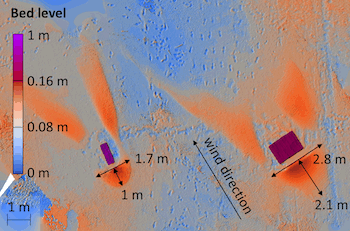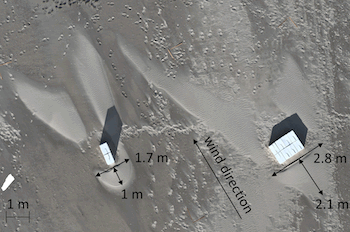D.W. Poppema1*, K.M. Wijnberg1, J.P.M. Mulder1 and S.J.M.H. Hulscher1
1 University of Twente,
Introduction
Worldwide, beaches are popular for recreation. As a result, people have built (holiday) houses, restaurants and other buildings at the land-sea interface. These buildings affect the wind field and wind-driven sand transport in their surroundings, thereby shaping the development of the beach-dune system. Currently, society is facing a growing demand for buildings on the beach, but at the same time it lacks knowledge on the effect these buildings have. Therefore, we aim to understand the effect of buildings on the beach-dune interface. In this contribution, we present the results of a field experiment that, as a first step, documents the effect of building geometry on the size of aeolian deposition patterns around buildings in an open sandflat setting.
Methods
During the experiment, cuboid scale models of buildings were placed on the beach at the Sand Motor. The scale models varied in size, where length, width and height ranged between 0.3 and 2 m. The length and width of the deposition patterns around the scale models were measured after 1 day using structure-from-motion photogrammetry. Photos, taken from a height of approximately 5 metres, were computationally combined into an orthophoto (distortion-free top view) and elevation map. In addition, wind speed and direction were measured, as well as the height of the saltation layer by a vertical array of Wenglor sensors. In total, over 4 days, 31 scale models have been tested.
Results
The experiment showed different types of deposition and erosion patterns that can be found around buildings at the beach (see Poppema et al., 2019). The width and length of deposition patterns depended strongly on scale model width (w), and to a lesser degree on scale model height (h). Scale model length had little effect. Especially the combined effect of  showed a strong correlation. From aerodynamic theory, the effects of scale model width and height on flow structures are expected to be of similar strength. However, sediment transport is present in a layer close to the bed and hence scales mainly with scale model width. The deposition is the result of an interplay between sediment transport and flow structures, which explains the strong effect of scale model width and the weaker effect of scale model height.
showed a strong correlation. From aerodynamic theory, the effects of scale model width and height on flow structures are expected to be of similar strength. However, sediment transport is present in a layer close to the bed and hence scales mainly with scale model width. The deposition is the result of an interplay between sediment transport and flow structures, which explains the strong effect of scale model width and the weaker effect of scale model height.


Figure 1 A DEM (left) and orthophoto (right) of de deposition around two scale models that vary in width
References
Poppema, D.W., Wijnberg, K.M., Mulder, J.P.M. & Hulscher, S.J.M.H. (2019): Scale experiments on aeolian deposition and erosion patterns created by buildings on the beach, Coastal Sediments 2019, 1693-1707.
I. Surname1*, F.N. Another-Surname2 , Y. Next-Surname2
1 University Name, Country; 2 Organization Name, Country
* Corresponding author: mail.name@organization.org


